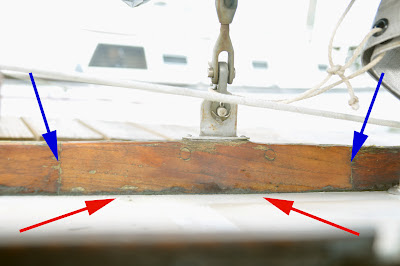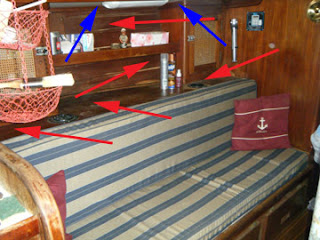LED lighting is available at West Marine but it is very expensive and not as versatile as what you can order online. I reviewed the specs for the LED strips from West, and the ones I can find on Amazon seemed to be fairly similar in that they were the bright LED style strips and waterproof, but the ones from Amazon were also able to be cut to any length and could be set to change colors if desired.
Link to Amazon RGB LED Lights
 |
| Thin Cedar Strips mounted |
We cut thin strips of the cedar wood and drilled thin pilot holes through it every 18 inches or so. We then drilled a small countersink hole at each one so that when mounted to the walls, the screws would be flush.
These particular LED lights came with a 120V AC to 12V DC adapter included in the kit which allowed me to toss that and wire these directly into the boat's 12v DC system. When we did the refit in the stateroom, we planned to add lights later so already had wiring into each of the 4 corners of the room.
 |
| LED's mounted to cedar strips |
When installing these lights, we installed the small electronic component, and Infra Red Remote receiver into the corner of the stateroom (where later we will install a small shelving unit with power in it to charge cell phones and Ipad's and store eyeglasses when sleeping).
Once the wiring was connected to the connector for the LED's we mounted the LED strips to the cedar strips facing down. These particular LED's come with a 3M adhesive backing but I don't suspect that will hold up in the varied temperatures on the boat. We are adding some epoxy glue to the back side as well to ensure they stay put.
The scalloped molding was also cut to the proper length, had pilot holes drilled, as well as counter sinks allowing us to install and fill the screw holes with bungs after the fact. Every time in the past we had installed anything that was wood on the boat, we have used a good hardwood (either Teak or Mahogany) but in this case we chose to use a simple pine molding and stain it to the color we wanted.
 |
| All my wiring tools (meter, shrink wrap, marine crimps), etc |
After staining the pieces, we applied multiple coats of varnish like the rest of our interior projects. Once dry we installed these pieces of molding to the cedar strips with the top of the molding flush with the top of the cedar strip so that it creates a void aiming downward for the lights to shine down without being able to see them directly.
We are happy with the way the LED's have turned out and will also be doing something similar in the Salon as we wrap up that part of the refit as well. The good news is that the entire strip of LED's in the stateroom (about 16 feet of them) still draws minimal amps and are better than the 2 double filament fixtures that were back there before we started the refit. It is a pleasant surprise to turn on all of the boats LED lighting throughout and watching the DC Ammeter barely move.
Below is a short video we did showing what the lights look like in operation. We filmed them with the lights changing colors but I don't see us using it that way, I suspect that we will just have a single color when they are on.
















